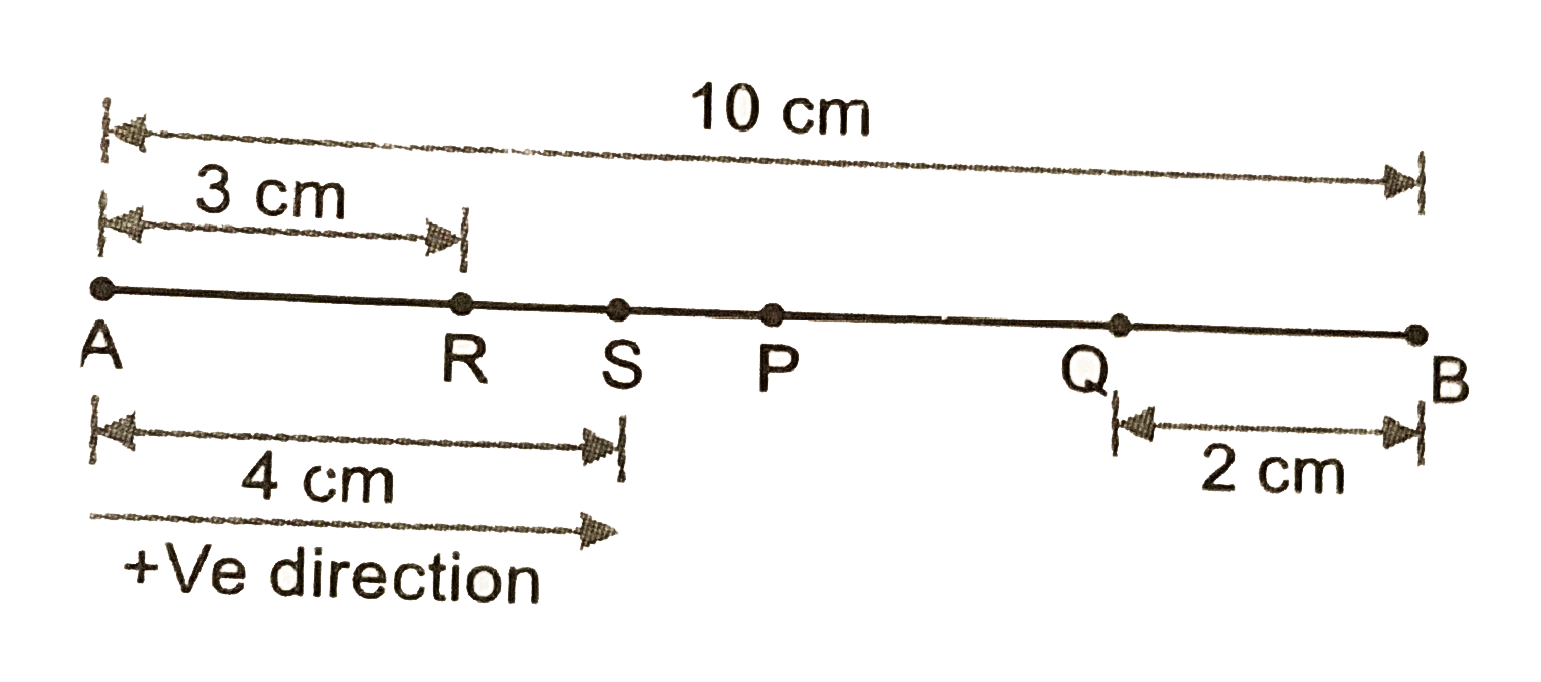A particle is in linear S.H.M. between two points A and B, 10 cm apart. Take the direction from A to B as the positive direction and give the signs of velocity, acceleration and force on the particle when it at 3 cm away from A going towards B
Refer Fig., here A and B represent the two extreme positions of an S.H.M. For velocity, the direction from A and B is taken to be positive. For acceleration and the force, the direction is taken positive if directed along AP and negative if directed along BP.

At 3 cm away from A going towards B. the particle is at R, with a tendency to move along RP, which is positive direction. Here, velocity, acceleration and force are all +ve.
Topper's Solved these Questions
- OSCILLATIONBook:AAKASH SERIESChapter:OSCILLATIONExercise:VERY SHORT ANSWER TYPE QUESTIONS
Explore 31 Videos
- OSCILLATIONBook:AAKASH SERIESChapter:OSCILLATIONExercise:NUMERICAL EXERCISE (LEVEL-1)
Explore 33 Videos
- NEWTONS LAWS OF MOTION Book:AAKASH SERIESChapter:NEWTONS LAWS OF MOTION Exercise:ADDITIONAL PRACTICE EXERCISE PRACTICE SHEET (ADVANECED) (Matrix Matching Type Questions)
Explore 1 Video
- OSCILLATIONSBook:AAKASH SERIESChapter:OSCILLATIONSExercise:PRACTICE EXERCISE - SPRINGS
Explore 16 Videos
Similar Questions
Give two examples of periodic motion which are not oscillatory ?
View SolutionThe frequency of a particle performing SHM is 12Hz. Its amplitude is 4cm. Its initial displacement is 2cm towards positive extreme position. Write its equation for displacement.
View SolutionThe system shown in the figure is given an acceleration 'a' towards left. Assume all contact surfaces to be smooth (m: mass of the sphere) The magnitude of the contact force between wedge and sphere between wedge and sphere at A is xmg√3 then 'x' is

View SolutionA ball of mass 2kg hanging from a spring oscillates with a time period 2p seconds. Ball is removed when it is in equilibrium position, the spring shortens by
View SolutionA particle is in linear S.H.M. between two points A and B, 10 cm apart. Take the direction from A to B as the positive direction and give the signs of velocity, acceleration and force on the particle when it is.
(a) at the end (A) at the end B,
(c) at the mid point of AB going towards A,
(d) at 2 cm away from B going towards A,
(e) at 3 cm away from A goiing towards B, and
(f) at 4 cm away from A going towards A.

View SolutionA particle is in linear simple harmonic motion between two points, A and B, 10 cm apart. Take the direction from A to B as the positive direction and give the signs of velocity, acceleration and force on the particle when it is at the end B.
View SolutionA particle is in linear simple harmonic motion between two points, A and B, 10 cm apart. Take the direction from A to B as the positive direction and give the signs of velocity, acceleration and force on the particle when it is
at the end B.
View SolutionA particle is in linear simple harmonic motion between two points, A and B, 10 cm apart. Take the direction from A to B as the positive direction and give the signs of velocity, acceleration and force on the particle when it is
at 3 cm away from A going towards B.
View SolutionA particle is in linear S.H.M. between two points A and B, 10 cm apart. Take the direction from A to B as the positive direction and give the signs of velocity, acceleration and force on the particle when it is. (a) at the end A (b) at the end B, (c) at the mid point of AB going towards A, (d) at 2 cm away from B going towards A, (e) at 3 cm away from A goiing towards B, and (f) at 4 cm away from A going towards A.
View SolutionA particle is in linear simple harmonic motion between two points, A and B, 10 cm apart. Take the direction from A to B as the positive direction and give the signs of velocity, acceleration and force on the particle when it is
at 3 cm away from A going towards B.
View SolutionA particle is in linear simple harmonic motion between two points, A and B, 10 cm apart. Take the direction from A to B as the positive direction and give the signs of velocity, acceleration and force on the particle when it is at the end B.
View SolutionA particle is in linear simple harmonic motion between two points, A and B, 10 cm apart. Take the direction from A to B as the positive direction and give the signs of velocity, acceleration and force on the particle when it is at the end B.
View SolutionA particle is in linear simple harmonic motion between two points, A and B, 10 cm apart. Take the direction from A to B as the positive direction and give the signs of velocity, acceleration and force on the particle when it is
at 3 cm away from A going towards B.
View SolutionA particle is in linear S.H.M. between two points A and B, 10 cm apart. Take the direction from A to B as the positive direction and give the signs of velocity, acceleration and force on the particle when it at the end A.
View SolutionA particle is in linear S.H.M. between two points A and B, 10 cm apart. Take the direction from A to B as the positive direction and give the signs of velocity, acceleration and force on the particle when it at the end B.
View Solution

